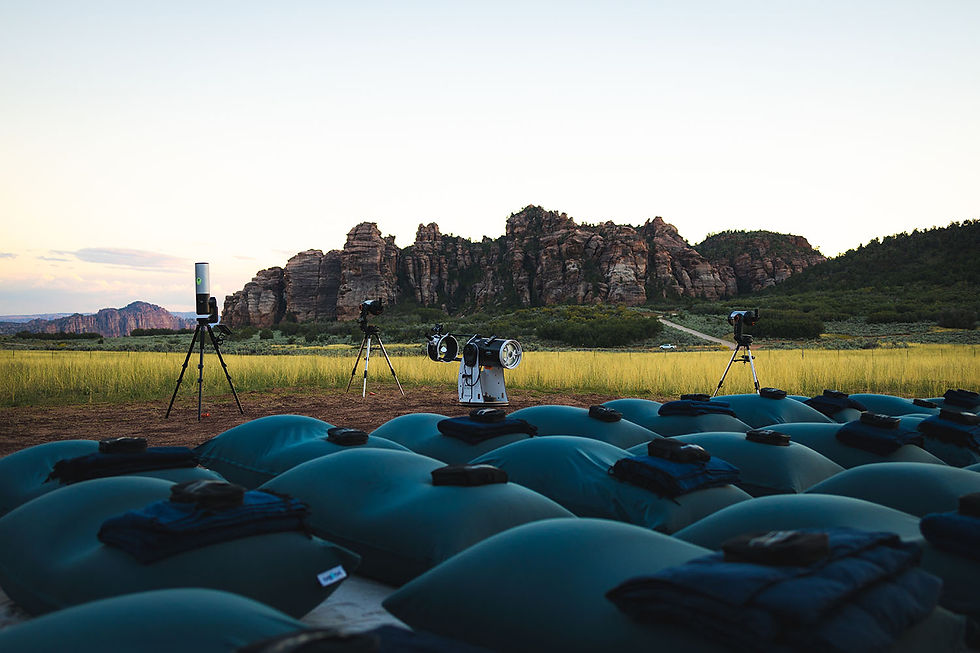Celebrating Zion's Dark Skies
- Matthias Schmitt

- Apr 14, 2023
- 4 min read
Updated: Apr 2
The map below from www.darksitefinder.com shows the continental U.S. and the effects of artificial light on the night sky. Colors, up to white, indicate a large amount of artificial light, and bluish to no color indicates a small amount or no artificial light. The higher the concentration of people living in an area, the more artificial light they seem to produce. You can see large metropolitan areas like Los Angeles on the West Coast, Dallas and Chicago in the center, and New York on the East Coast.

Image: Concentration of artificial light across the continental U.S. Source: DarkSiteFinder.com
Why are the Dark Skies of Zion Important?
Our ancestors, that lived thousands of years ago, did not have this challenge. They were hunter-gatherers and nomads and used the sky as a clock, calendar, and canvas on which they painted what they encountered daily, like animals (Bulls, Dogs, Fish, etc.). One of the oldest indications of the fascination of Homo Sapiens (that’s us) with the night sky is the cave paintings in Lascaux, France. They show the stars we know today as Taurus the Bull and a little cluster of stars known as The Pleiades or Seven Sisters. That was 15000 to 17000 years ago. It must have made an impression on them to memorialize them on the ceilings of a dark cave. We encounter the Pleiades again in the sky disk of Nebra from Germany, a metallic disc roughly 3500 years ago and thought to be the oldest star map. What do people in the future remember of us when looking at the sky if they can still see the stars?

Image: Sky Disk of Nebra in the Natural History Museum in Halle (Saale). Photo by Matthias.
Today, we can barely see the brightest, first-magnitude stars in metropolitan areas. When I lived in New York City, I saw more stars on Broadway than in the sky (There weren’t that many). Once I moved out West and saw the Milky Way high in the sky and thousands of stars, I was very, very moved, and I went, “WOW!” I am a German scientist stereotyped to be lacking emotions! I wondered if this is how our ancestors felt and if others might feel the same way. If we re-establish this connection with the night sky, might we live differently and be more mindful of the impact that our actions have on the natural world?
What Can We do to Preserve Dark Skies in Utah?
Our primary interest as a business is that we can operate in an environment conducive to providing an excellent service to our guests: a dark night sky. We would like to have the minimum amount of artificial light to see as many stars as possible and the Milky Way. This experience is degraded by misdirected light from cities and surrounding communities. And we are lucky! The night skies have degraded significantly over the last ten years.
We are not against the use of light — we need it to live our modern lives. But we think there is a sensible, easy way to curb artificial light, not just for the benefit of our business but also for people’s health, safety, wildlife, and plant life. Here are five simple ways for responsible outdoor lighting suggested by the International Dark-Sky Association, a non-profit advocating for dark skies:

Many communities have pursued these principles to benefit their citizens, e.g., Torrey, UT, Flagstaff, AZ, and Lakewood Village, TX, to name a few. In addition, plenty of national parks in the area have received their dark sky designation, like Cedar Breaks National Monument, Zion National Park, and Bryce Canyon National Park. Those parks receive millions of visitors for their natural splendor during the day and their dark skies. The parks aim to preserve and protect the night sky as a natural and cultural resource for this and future generations. Utah boasts the highest concentration of dark sky parks in the world! Something we can be proud of as Utahns.
We all Benefit from Keeping Night Skies Dark
Dark skies are good for getting visitors to national parks and benefit human health, wildlife, and planet life. We are altering a natural cycle of day and night that can affect our sleep, especially when you look at a bright screen in your bed! Wildlife can fly into lit-up buildings and die, and plant life alters their natural hibernate-and-growth cycle. The adverse effects are many. You might think, what are a few more birds or plants dying? You might also see where this thinking leads.
As a business and the individuals that work for it and live in communities like Virgin, Springdale, and St. George, we support the sensible use of light (just installing proper light bulbs can save tens of thousands of dollars) and contribute to conserving this common good and natural wonder.
Our guests always leave with a sense of connection to the night sky and the Universe. We hope you can join our efforts so we can live a little bit more like our ancestors who marveled at the stars in quiet amazement and wonder.

Image: A night sky tour in June of 2022 with Zion’s Tabernacle Dome and the Milky Way in the background.
Come Celebrate Zion's Dark Skies with Stargazing Zion!
Since Zion is an International Dark Sky Park and they go above and beyond with dark sky conservation in Utah, it's a great place to enjoy stargazing and viewing the milky way! Here at Stargazing Zion we offer professional stargazing tours under Zion's dark skies with the beautiful backdrop of the Utah desert. Whether you are a regular stargazer, an astronomer or have never been stargazing before, stargazing in Utah with Stargazing Zion is a great way for an exceptional night of viewing the stars in some of the darkest skies of the country!
Organizations we support in their efforts:



Comments